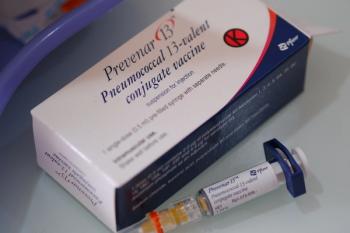
- Drug Topics September 2020
- Volume 164
- Issue 9
Adult Pneumonia Management and Prevention
Pharmacists can play an important role in pneumonia management and prevention.
Pneumonia is a lung infection that can result in mild to severe illness across all ages, and common causes include viruses, bacteria, and fungi. Individuals at high risk of experiencing pneumonia include adults 65 years or older, children younger than 5 years, those with underlying health conditions, and smokers.1 Common causes of viral pneumonia are influenza and respiratory syncytial virus.1 Bacterial pneumonia is commonly caused by Streptococcus pneumoniae (pneumococcus), and it is important for patients to get the pneumococcal vaccine for prevention.2
Community-Acquired Pneumonia (CAP)
Treatment Recommendations Pharmacists can ensure that patients receive appropriate treatment for community-acquired pneumonia (CAP), which is acquired outside of the hospital setting. The CAP treatment guidelines were recently updated to recommend amoxicillin as a first-line agent unless patients have a penicillin allergy.3 Healthy outpatient adults with CAP who do not have underlying health conditions or risk factors for antibiotic resistant pathogens should receive 1 of the following treatments: amoxicillin 1 g 3 times daily (first line), or doxycycline 100 mg twice daily, or a macrolide (azithromycin 500 mg on the first day then 250 mg daily, or clarithromycin 500 mg twice daily, or clarithromycin extended release 1000 mg daily).3 Evidence suggests that pneumococcal resistance (over 30%) can be associated with macrolides so this should be taken into consideration when selecting CAP treatments.3 Pharmacists should also educate patients about cardiac risks associated with azithromycin, including QTc prolongation, and assess for any potential drug interactions.3
Patients with CAP and comorbidities should receive broader spectrum treatment in the outpatient setting.3 Combination therapy with amoxicillin/clavulanate or a cephalosporin (cef-podoxime, cefuroxime) and a macrolide (azithromycin, clarithromycin) or doxycycline should be started for initial treatment.3 Reserve fluoroquinolone monotherapy (levofloxacin, moxifloxacin, or gemifloxacin) for patients with drug-resistant CAP or ß-lactam allergies.3 Educate patients about serious adverse effects (AEs) that have been associated with fluoroquinolones, including tendinitis, tendon rupture, hypoglycemia, peripheral neuropathy, and mental health issues.4
Individuals hospitalized with CAP will typically need combination therapy with a ß-lactam (ampicillin plus sulbactam, or cefotaxime, ceftriaxone, or ceftaroline) and a macrolide.3 Fluoroquinolone monotherapy (levofloxacin or moxifloxacin) can also be used. Patients with contraindications to macrolides and fluoroquinolones can receive combination therapy with a ß-lactam and doxycycline.3
Hospital-Acquired Pneumonia
(HAP) and Ventilator-Associated Pneumonia (VAP) Nosocomial pneumonia, or hospital-acquired pneumonia (HAP), may occur during a hospital stay, and patients may experience ventilator-associated pneumonia (VAP) after being on a ventilator.5
Melissa Santibañez, PharmD, BCCCP, a critical care pharmacist and an assistant professor in the department of clinical and administrative sciences at Larkin University College of Pharmacy in Miami, Florida, said that patients can present to the intensive care unit (ICU) with pneumonia due to any causative organism, including bacterial, viral, and fungal. Patients admitted to critical care units are also more likely to have complicating comorbidities, baseline immunosuppression, or other risk factors for multidrug-resistant organisms (eg, mechanical ventilation, indwelling venous catheters, parenteral nutrition, renal replacement therapy, or nursing home residence).
“The pharmacists’ role in these cases is essential, as they can ensure that patients receive ventilator pneumonia precaution order sets and that certain medications are being replaced regularly to prevent bacterial colonization (eg, administration lines for propofol and lipids),” said Santibañez. Pharmacists can play an integral role in proper antimicrobial prophylaxis against expected opportunistic infections for immunocompromised patients. “If a patient has been previously infected by a multidrug-resistant organism and/or had recent antimicrobial exposure within the past 90 days, infection prophylaxis and treatment regimens must be modified to ensure that the resistance patterns are being adequately covered and to minimize the likelihood of developing additional resistance,” she said.5
COVID-19 Pneumonia Treatment
Patients with COVID-19 pneumonia and those who are critically ill with non–COVID-19 pneumonias present in a similar fashion, as there is both an infectious part and an acute respiratory failure component to the illnesses. “More information is surfacing to sug- gest that recovery from COVID pneumonia is only the beginning, as ICU survivors of COVID pneumonia may still need to battle residual symptoms and a slowed return to baseline functioning upon their discharge,”said Santibañez.
The FDA issued an Emergency Use Authorization for remdesivir for the treatment of hospitalized patients with COVID-19.6 The National Institutes of Health (NIH) treatment guidelines were recently updated recommending prioritizing limited supplies of remdesivir for hospitalized patients with COVID-19 who require supplemental oxygen but who are not on high-flow oxygen, non- invasive ventilation, mechanical ventilation, or extracorporeal membrane oxygenation (ECMO), as there is inadequate evidence of clinical benefit for these individuals.7
The NIH guidelines were also recently updated to recommend the corticosteroid dexamethasone based on the preliminary results from the Randomized Evaluation of COVID-19 Therapy trial (RECOVERY; NCT04381936).7,8 Preliminary data from RECOVERY revealed that the mortality rate was lower among patients who were randomized to receive dexamethasone than among those who received standard of care.8 Based on these results, the NIH recommends using dexamethasone 6 mg per day for up to 10 days for the treatment of COVID-19 in patients who are mechanically ventilated and in those individuals who require sup- plemental oxygen but who are not mechanically ventilated.7 Clinicians should not use dexamethasone for the treatment of COVID-19 in patients who do not require supplemental oxygen.7
Santibañez noted that dexamethasone access has become challenging because many wholesalers have run out of the drug. Clinicians may use alternative corticosteroids (eg, prednisone, methylprednisolone, or hydrocortisone) if dexamethasone is not available.7
Pneumonia Prevention Strategies
Pharmacists should educate patients about the pneumococcal vaccine and administer it to the recommended population (see Table 19). As individuals with influenza can also develop pneumonia, it is important for pharmacists to encourage patients to get an annual flu vaccine to prevent this complication. Patients can also lower the risk of pneumonia by ensuring that chronic medical conditions are controlled and by quitting smoking.2 Additionally, frequent handwashing with soap and water, wearing a mask, and social distancing are effective ways to prevent COVID-19 and complications including pneumonia.
References:
- Causes of pneumonia. CDC. Updated March 9, 2020. Accessed August 7, 2020.
https://www.cdc.gov/pneumonia/causes.html - Pneumonia can be prevented––vaccines can help. CDC. Updated November 21, 2019. Accessed August 7, 2020. https://www.cdc.gov/pneumonia/prevention.html
- Metlay JP, Waterer GW, Long AC, et al. Diagnosis and treatment of adults with community-acquired pneumonia: an official clinical practice guideline of the American Thoracic Society and Infectious Diseases Society of America. Am J Respir Crit Care Med. 2019;200(7):e45-e67. doi:10.1164/rccm.201908-1581ST
- FDA reinforces safety information about serious low blood sugar levels and mental health side effects with fluoroquinolone antibiotics; requires label changes. FDA. Updated July 10, 2018. Accessed August 8, 2020. https://www.fda.gov/drugs/drug-safety-and-availability/fda-reinforces-safety-information-about-serious-low-blood-sugar-levels-and-mental-health-side
- Kalil AC, Metersky ML, Klompas M, et al. Management of adults with hospital-acquired and ventilator-associated pneumonia: 2016 clinical practice guidelines by the Infectious Diseases Society of America and the American Thoracic Society. Clin Infect Dis. 2016; 63(5):e61-e111. doi:10.1093/cid/ciw353
- Remdesivir EUA letter of authorization. FDA. May 1, 2020. Accessed August 9, 2020. https://www.fda.gov/media/137564/download
- COVID-19 treatment guidelines. NIH. Updated July 30, 2020. Accessed August 9, 2020. https://www.covid19treatmentguidelines.nih.gov/whats-new/
- Horby P, Lim WS, Emberson JR, et al; RECOVERY Collaborative Group. Dexamethasone in hospitalized patients with COVID-19––preliminary report. N Engl J Med. Published online July 17, 2020. doi:10.1056/NEJMoa2021436
- Pneumococcal vaccination: summary of who and when to vaccinate. CDC. Updated November 21, 2019. Accessed August 9, 2020. https://www.cdc.gov/vaccines/vpd/pneumo/hcp/who-when-to-vaccinate.html
Articles in this issue
about 5 years ago
Boston Medical Center Reduces Opioid Use in Surgical Patientsabout 5 years ago
A Partnership to Optimize Medication Use and Patient Outcomesover 5 years ago
Biosimilars May Lead to Improved Competition and Lower Costsover 5 years ago
Prevent Medication Errors in Autoimmune Diseaseover 5 years ago
A Look at the Year in Genericsover 5 years ago
The Rise of AIover 5 years ago
Medication Therapy Managementover 5 years ago
The Pharmacist’s Role in Generic SubstitutionNewsletter
Pharmacy practice is always changing. Stay ahead of the curve with the Drug Topics newsletter and get the latest drug information, industry trends, and patient care tips.





























































































































